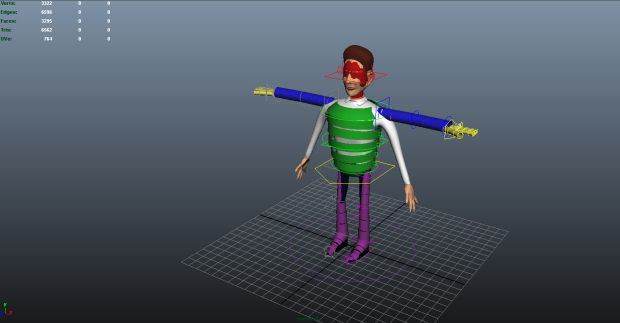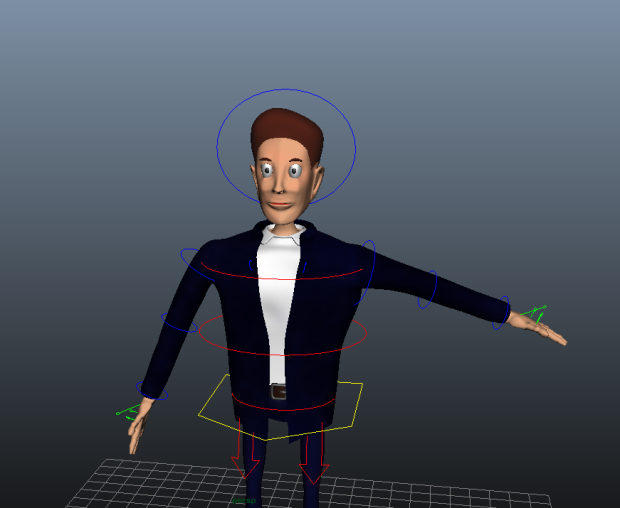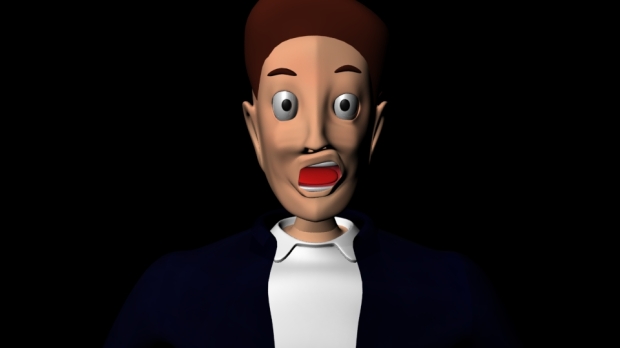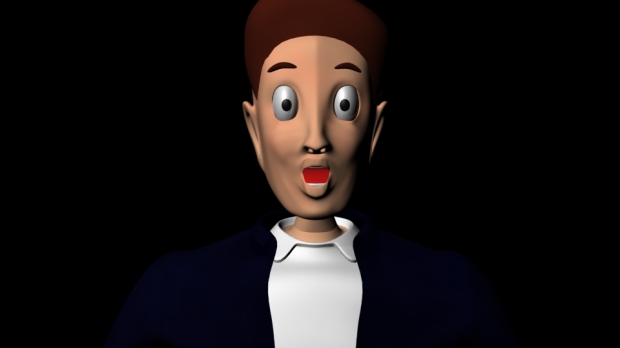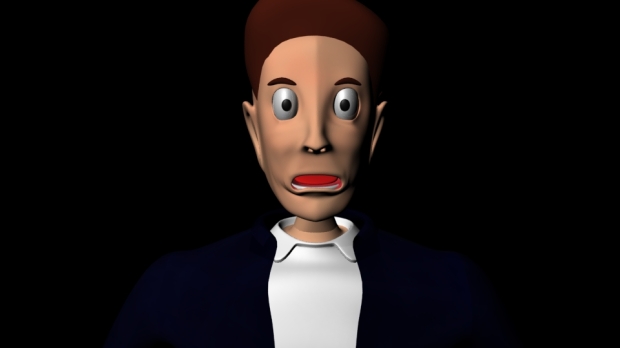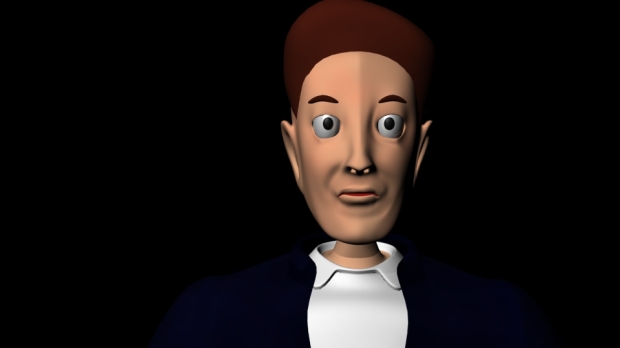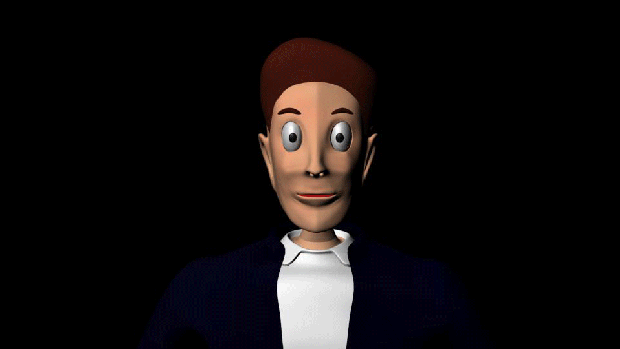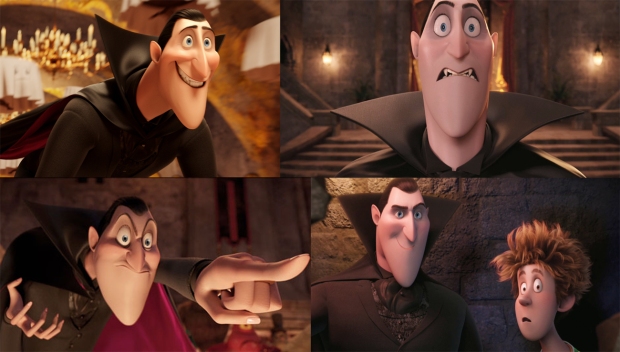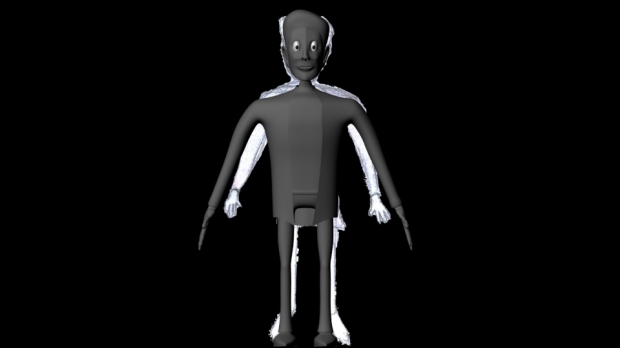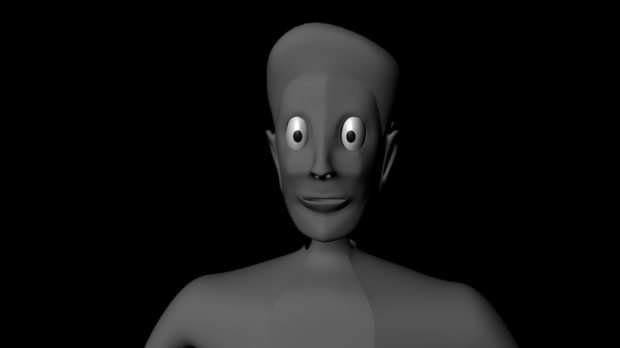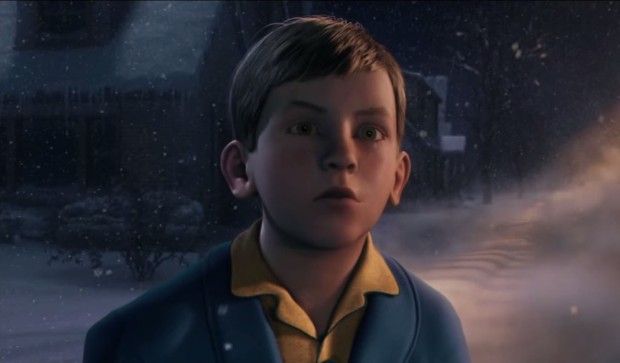Recently I’ve rigged my character using The Set Up Machine. As you can see below I had to tweak few things, such us influences on the skin, so the jacket would act naturally and wouldn’t dissolve in the character’s body. What’s ahead of me is the final animation. I’ve decided to slightly change my story. Now I want to do it in one camera angle and completely focus on characters faces. He’ll be sat by thinking about his past. I want the expressions to be clear to the audience and want the audience to empathise with the character.
facial animation
Blendshapes and blinking gif
Recently I was working on blendshapes for my character. As I’ve previously mentioned, most of the expressions that I wanted to portray were suppose to be illustrate sad and rather negative emotions. I was trying to make some expressions asymmetrical, as in my research I found out that asymmetry brings interest to the character and gives the pose energy. It seems that the expressions are symmetrical mainly when character is either bored, or in a position of authority, or has no emotions.
Refrences:
Norm, Tuesday Tips – Asymmetry in facial expressions. 2014 [online] Griz and Norm blog, Available at: http://grizandnorm.tumblr.com/post/79975572030/tuesday-tips-asymmetry-in-facial-expressions-a
Exaggerated facial features and problems with them
In my research I found that exaggeration plays an important role in animation, it’s even considered to be a part of 12 basic principles of animation. Realism can be considered to be dull and static, especially when it comes to movement in animation and exaggeration takes it to certain extremes to make it appear more entertaining and exciting, especially when characters are designed in a cartoony style, rather than photo-realistic. I’ve noticed it in my work from my undergraduate degree when it was lacking exaggeration and the results weren’t as good as expected. But exaggeration doesn’t always improve the work straight away.
For my final project I’ve decided to design a character with exaggerated facial features, and while large eyes and bigger, overemphasised eyebrows bring some results and make a character look more interesting, more appealing, but in my design I was too concious and instead of focusing on one style, I was trying to balance between photorealism and cartoony, caricature style. This started to cause some issues when it came to doing blend shapes. Getting some particular mouth shapes turned out to be harder than I’ve initially assumed. Character’s high and emphasised cheek bones give him some charm, make him look slightly different than a typical character, but they also limit some of the facial movement. That’s something that I didn’t considered while designing the character.
Eye brows
Last week I covered large eyes, but what about another facial feature that is also expressive and can be used in improving facial expressions and character performance? There is something about the eyes and eyebrows that draw our attention to them. . In “The Artist’s Complete Guide to Facial Expressions”, Gary Faigin says : “ We instinctively feel that the eyes provide our most direct link to the person within. The brows too seem to have a life of their own”. As opposed to the eyes, eye brows are capable of bigger shape change and they also can change the shape of the eye. Later, in the same book, Faigin says: “Considering how much can be expressed by the eyes and brow, it is surprising that there are only five muscles responsible or it all (…) Our control over these muscles is so fine-tuned that we can express virtually the whole range of emotions with just a little twist here, a little lift there: our perception is so practiced that we can instantly recognize the differences.”
Eyebrows can be useful in exaggerating the performance, like in this example, from Ace Ventura(starts around 0:20):
But they can also be used in more serious performance, not as exaggerated, but still noticeable:
But let’s focus on animation, in this short clip from Pixar’s “Ratatouille” we can see that a lot of emotions is communicated through the eyebrows. Clearly the exaggeration works, we can especially see it in chef Skinner performance. Even that his brows are almost hidden under his huge hat, we can see how much more alive his performance is because if the brows:
While doing my research about eyebrows I came across a good advice provided by Pixar’s animator, Victor Navone, which says that to make the brows stand out and make sure that the audience won’t miss the movement, it is a good idea to have the brow animation preceding any head or body movement. It also can be used to show that character is thinking. He also mentioned other tips such us:
- As the pitch of the voice raises the brows go up
- As the pitch of the voice lowers, the brows likewise drop
- When asking a question where the answer is already known, the brows raise
- When asking a question where the answer is truly unknown, the brows lower
- Spontaneous facial expressions (surprise, fear, pain, etc.) tend to be symmetrical, where as expressions we choose to make (curiosity, suspicion, contempt, etc.) can be more asymmetrical.
http://www.carlosbaena.com/resource/resource_tips_brows.html
http://blog.navone.org/2009/02/brows-have-it.html
Faigin G., 1990 The Artist’s Complete Guide to Facial Expressions
Progress – modelling a character
My progress since last week in modelling my main character, Shaun. I still need to model his shirt, add details to his belt(right now it just looks like his shirt is ending there) and add a tie to him. Next would be unwrapping, texturing and rigging him. According to my timetable I should already be doing that so I’m a week behind. There’s also only two months left till the deadline so I might used my backup plan and used a prerigged character for my female character. I’ll probably make the final decision by the end of next week. I’m still not sure about his eyes, as they do look kind of creepy in my opinion, however a similar design worked well in “Hotel Transylvania”, where Dracula’s eyes were similar. Another good example from that movie is Johnny, who also has long, narrow eyes). This short clip gives a good example of how many amazing expressions Sony animators were able to achieve with this character:
It clearly doesn’t just focus on facial expressions, as there’s a lot of running around and body movement but in my opinion the expressions that character makes make the entire scene much more enjoyable and interesting to the viewer, therefore I would argue that they play the major role in making us, the audience empathise with the character.

Hotel Transylvania – Johnny
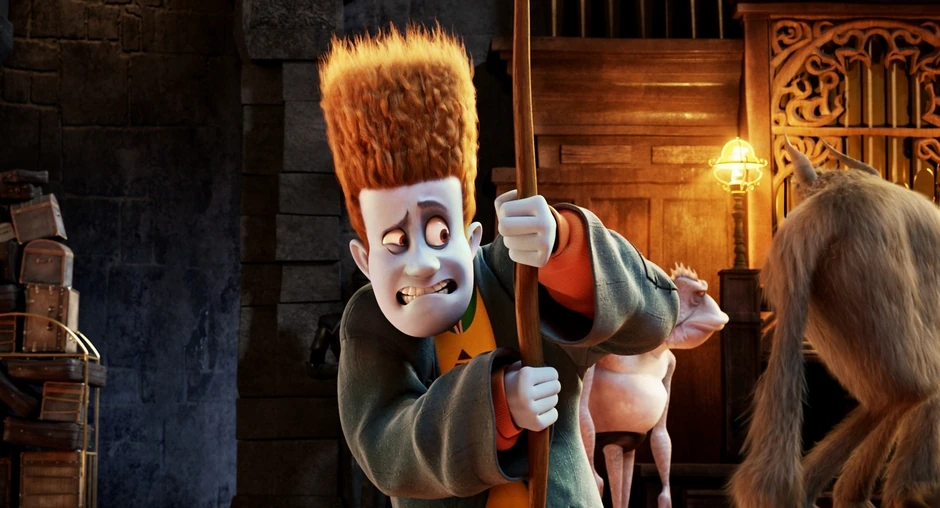
Hotel Transylvania – Johnny 2

Hotel Transylvania – Johnny 3
Sources: image 1: http://www.visualhollywood.com/movies_2012/hotel_transylvania/photos/
image 2: http://pixshark.com/hotel-transylvania-dracula.htm
image 3: http://hoteltransylvania.wikia.com/wiki/Dracula
image 4: http://pixshark.com/hotel-transylvania-dracula-bleh-bleh-bleh.htm
image 5: http://pixshark.com/hotel-transylvania-johnny-stein.htm
image 6: http://hoteltransylvania.wikia.com/wiki/File:Johnny_broom.jpg
image 7: http://www.rotoscopers.com/2012/03/14/first-official-images-of-hotel-transylvania/
Dead eyes characters
In my previous entry I’ve mentioned the role of eyes and dead eyed characters in films like “Polar Express”(2004) and how important the role of eyes is in expressing character’s emotions and making the character more likeable and believable. Having character’s with convincing eyes is important to the overall appeal of the character. For example let’s look at this video, it’s from the comedy show but it does rise an important issue. Conan is a what we could say is an example of a common viewer, a potential target audience. He’s not an expert in animation, computer graphics, games but straight away he can tell that there’s something not right with the character’s eyes.
In an article for The New Yorker, Derek Bradley, from Disney Research has said that “A lot of the dead-eye look can come from the animated motion of the eye rather than the static shape,”(2015) and then “If the dynamics of the eyes are not a hundred per cent correct, then it’s something people pick up on.”(ibid) Therefore I’ve decided to look at some examples of dead eye in animation and compare it to what I consider good examples of eye movement.
In this clip we can see a fair share of face close up so it gives us a chance of examining the facial expressions of the characters. From beginning it is quite hard to ignore the photorealistic design of the characters and it was already slightly off-putting. I have to say that it is hard to pick some eye movements that are out of place, it all looks well done, which is not surprising, as it was a big production. For me the fact that the eyes are design so lifelike, yet they clearly don’t look alive is already ruining the whole animation. Boy’s eyes seems to be very shiny but they are soulless. His face is also very smooth which makes it look plastic.
“Beowulf”(2007) is another example of motion capture animation and photorealistic characters. It also has the dead eye look. Characters still seem to be soulless. Let take a look at two images from the that scene. The first one is supposed to illustrate anger, while the 2nd one is showing confusion. I feel like they don’t achieve their goals, especially the second one. It’s probably more noticeable in the video clips than in stills. Again, characters look plastic.
Queen Wealtheow from Beowulf reminded me of Queen Lillian from Shrek 2 as they seem to be somehow similar from the design point of view. In comparison to the other characters from the movie, and from Shrek’s universe she’s very close to being photorealistic. Usually characters look more cartoony or some of their features are exaggerated but she seems fairly normal, but we could clearly see that her character isn’t eerie and isn’t in falling into the Uncanny Valley. What I’ve noticed is that her face and her eyes seem to be much more alive and natural that faces of characters in “Beowulf” or “Polar Express”. Her expressions are always changing and don’t looks static. There’s also a lot of asymmetry in her expressions.
I’m using an example of “The Incredibles”(2004) because it was released in the same year as “Polar Express” but it was a much bigger success and it was a critically acclaimed movie. Also it focused on human characters, in contrary to other Pixar films that were focusing on toys, bugs, cars or fish. What we can notice straight away is the fact that even that characters look very smooth and maybe plastic it is not off-putting like in the previous examples. Stylized design of the characters is definitely changing our perception of them. Again their far from the uncanny valley even that they are clearly human. When it comes to the expression again their very natural, sometimes exaggerated and asymmetrical. Thanks to this characters look interesting, alive, audience can emphasise with them and while before I said that they were soulless that it’s not the case here.
What I’ve learnt from this little analysis is the fact that there’s probably a long way until motion capture could marginalise character animators. In an effort to avoid dead eyes in characters I have to remember about the design of said character, it cannot be too realistic and when it comes to animating it, to give it some life I have to remember about eyebrows, eye darts, exaggerated movements and asymmetry.
King D., 2015, Building A Better Digital Eye [Online] The New Yorker, available at: http://www.newyorker.com/tech/elements/cgi-digital-animation-eye [Accessed at: 21.04.2015]
Uncanny Valley
The Uncanny Valley occurs when a CGI character(mainly human characters), or a robot, looks too realistic it makes people feel uneasy and uncomfortable. It also happens when the character tries to mimic a human behaviour but fails, when its movement isn’t quite right, it looks rather mechanical than natural, when the character tries to make an eye contact but fails. The phenomenon known to us since the 70’s, when the term was first used by a Japanese roboticist Masahiro Mori and ever since is a cause of a debate for scientist and artists.
Pixar avoided the uncanny valley effect by coming up with its own style of character design. It might not be a common knowledge but one of the reasons that pushed Pixar to achieve this was a the audience’s reaction to their short, “Tin Toy”(1988), featuring a very realistic looking baby character that freaked people out. Stylized characters let animators do so much more that realistic looking human characters.
A well-known example of the Uncanny Valle effects is the “Polar Express”(2004) and to a certain extent Beowulf(2007). What these two films have in common is a same director, Robert Zemeckis, and the fact that instead of using key frame animation, motion capture was used to capture actors facial expressions. What I’ve noticed is that even that the visuals in that film look pretty great the characters’ eyes look dead, they don’t have any emotions. Similar things could be said about characters in The Adventures of Tintin, in which also motion capture was used. I think that could be something that puts us off when it comes to realistically looking characters. It seems to me that the motion capture, which works fine when it comes to capturing body movement is still limited when it comes to facial expressions. That’s why Golum’s face, from Lord of The Rings was animated by actual animators and not by motion capture.
Here is an example that in my opinion works. The model is very realistic(when I first saw it I didn’t realise that it was CGI), however it doesn’t give any creepy vibes. The performance feels human, doesn’t look mechanical or unnatural. Of course after looking more into it we cane notice that her face looks too smooth, and there’s something different about her eyes, but I wouldn’t say they’re dead but I think it could be said that Image Metrics, company that’s behind this project successfully avoided the Uncanny Valley effect.
It seems to me that when it comes to animation eyes and eye brows are important in avoiding the uncanny valley. It’s something that motion capture can’t do, or can’t get it right at the moment and by focusing on that we can get much more natural looking expressions and much more interesting expressions. Some say that eyes are the window to the soul and we want our characters to look alive and believable.
HSU, J., 2012. Why “Uncanny Valley” Human Look-Alikes Put Us on Edge [online] Scientific American, Available at: http://www.scientificamerican.com/article/why-uncanny-valley-human-look-alikes-put-us-on-edge/ [Accessed date: 06.01.2015]
Snyder D. D., 2011, ‘Tintin’ and the Curious Case of the Dead Eyes [Online] The Atlantic, available at: http://www.theatlantic.com/entertainment/archive/2011/12/tintin-and-the-curious-case-of-the-dead-eyes/250432/ [Accessed date: 20.04.2015]
Rose S., 2011, Tintin and the Uncanny Valley: when CGI gets too real [Online] The Guardian, available at: http://www.theguardian.com/film/2011/oct/27/tintin-uncanny-valley-computer-graphics [Accessed date: 20.04.2015]
Adobe’s Character Animator and what does it mean for the industry
Few days ago Adobe released a video in which they present their latest software to the public. It’s called Character Animator and it’s able to motion track the head movements and facial expressions. One of its main advantages is how easy is it to rig a character. It’s also clear that it’s rather targeted at hobbyists, small corporate projects and maybe schools. I can’t imagine it being used in a professional environment on a big project. The software itself isn’t really an animation program, as it’s rather a motion capture software. It raises a question if this can be still called animation if no one is actually doing any animation. Purists would probably argue that it’s not, as the animation is an art form and there’s not a lot of art going on in motion capture. They could fear that it will make damage the industry, make it look as something easy to do and cause some jobs to disappear, but people had similar worries when CGI was becoming a big deal. I can’t imagine using any of the animation principles in that software, so at the end the result would be rather poor. But maybe that’s not the case? This software could be used during the planning and testing phase, if I was available now I would probably use it in my research as I can see a very little alternative for a motion capture of the face.
11 second club feedback
For the first time I’ve entered my animation into a 11 seconds club competition. It’s a well know internet community of animators. I sued this opportunity for my research and as a chance for an extra practice as well. Unfortunately I didn’t receive as much feedback as I was hoping for. It has been pointed out that the lighting was too bright and when it comes to actual animation and acting I was advised to focus on slow ins and slow outs and having more holds. I have to admit that there was pretty much no acceleration, especially on the male character. Slow in and slow out make the movement look more natural, because nothing moves with the same speed all the time and then drastically stop. Used well they will benefit the animation and make it look more lifelike. What I was trying to achieve was exaggeration in his movement but it turned out to be way over the top and looked more like a pantomime. It was not interesting to look at and the fast movement did not work with the story.
Here’s my entry: http://www.11secondclub.com/competitions/march15/entry/AsJCgm
Pose vs Movement 2 – John and a fly
After receiving feedback last week, I looked at the mistakes I’ve done and tried improving them this week. it was pointed out to me that even that I was focusing on animating someone watching something I haven’t done anything to the eyes. This week I’ve used another rig called “John”. John is middle aged guy who just came back from work and wanted to spend some time alone reading his favourite newspaper, however he got interrupted by a fly. Another thing that was pointed out to me was character’s inner monologue, even in a very short, test animation. So I also tried doing that in this animation. That’s why while he’s reading his newspaper his eyebrows are rising, and he’s blinking to show his thinking and his understanding of what’s he’s reading.
